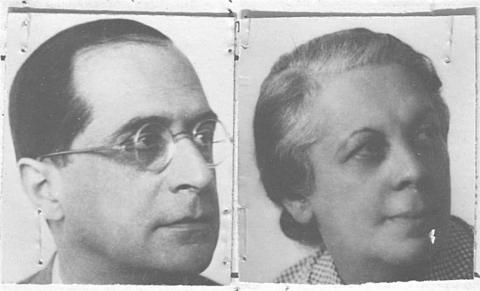Josef Morgenstern worked from the 1920s as a commercial agent and Prokurist (authorized signatory) for banks and the pipe industry in Vienna and Amsterdam. At the same time he studied political science at the University of Vienna, obtaining his doctorate in 1928. He was friends with the art dealer and publisher Otto Nirenstein and joined the Zentralvereinigung der Architekten (Central Association of Architects) as an associate member in 1921. In March 1922 he acquired a property at Apfelgasse 3 in Vienna's 4th district, where he and his wife Alice had apartment 8 furnished by the young architect Otto Bauer. The exclusive modern furniture designed by Bauer was described and pictured in contemporary architecture magazines. An article in Innendekoration in 1924 showed not only the furniture but also various artworks, including the painting Four Trees by Egon Schiele in the music room, which was to be presented in 1928 and 1930 at exhibitions in the Neue Galerie in Vienna and the Kunsthaus in Zurich. Few details are known of the rest of the art collection, but it is thought to have included a work by Paul Gauguin, various watercolours and engravings and a library of five thousand books.
At the time of the annexation in March 1938, Morgenstern was deputy director of the Röhrenkartell-Büro. On account of his Jewish origins he was dismissed in May 1938 by his employer, Kommanditgesellschaft Kontinentale Eisenhandelsgesellschaft Kern & Co, whereupon he and his wife sought to emigrate to North America. They officially left Vienna for Yugoslavia on 13 August 1938, having hitherto been obliged to sell their entire household, including the furniture, Steinway grand piano, sheet music, books and silverware at much less than their actual value because of their dire financial situation. The Morgensterns spent the first months after escaping on the island of Korčula. From there they travelled in December 1938 to Brussels after Josef Morgenstern had obtained a work visa in Zagreb. When German troops invaded Belgium in May 1940, he was arrested, deported to southern France and interned at the camp in Saint Cyprien. After it was closed at the end of 1940, he was transferred to Gurs and then to the Drancy transit camp. On 9 September 1942 he was deported on the thirtieth transport to Auschwitz, where he was murdered on an unknown date. His wife Alice remained in Brussels and managed to survive the war in hiding thanks to her landlady. Josef's only brother and Alice's three sisters were all victims of the Shoah.
Although suspicion arose immediately after the end of the Nazi regime that the Schiele work Four Trees, which was acquired by the Österreichische Galerie in 1943 from Kunsthandlung L. T. Neumann, had been expropriated, the gaps in its provenance have only recently been closed. They prove that Josef and Alice Morgenstern issued power of attorney before their flight in 1938 to their old friend and family lawyer Robert Röhrl (1886–1952) and gave him the painting for safekeeping. The documents also show that Alice Morgenstern did not discover the whereabouts of Four Trees until 1959, when it was shown in two exhibitions by the Österreichische Galerie in Luxembourg and Belgium. In correspondence with the Austrian authorities, she mentioned details of the flight and the loss of possessions, but the fate of the interior furnishings and art collection has still not been established. Alice Morgenstern died on 25 October 1970 in poverty in a Jewish old people's home in Brussels. On the basis of this new information, the Art Restitution Advisory Board recommended in its meeting of 6 March 2020 that the painting Four Trees be restituted to the legal successors of Josef and Alice Morgenstern.

